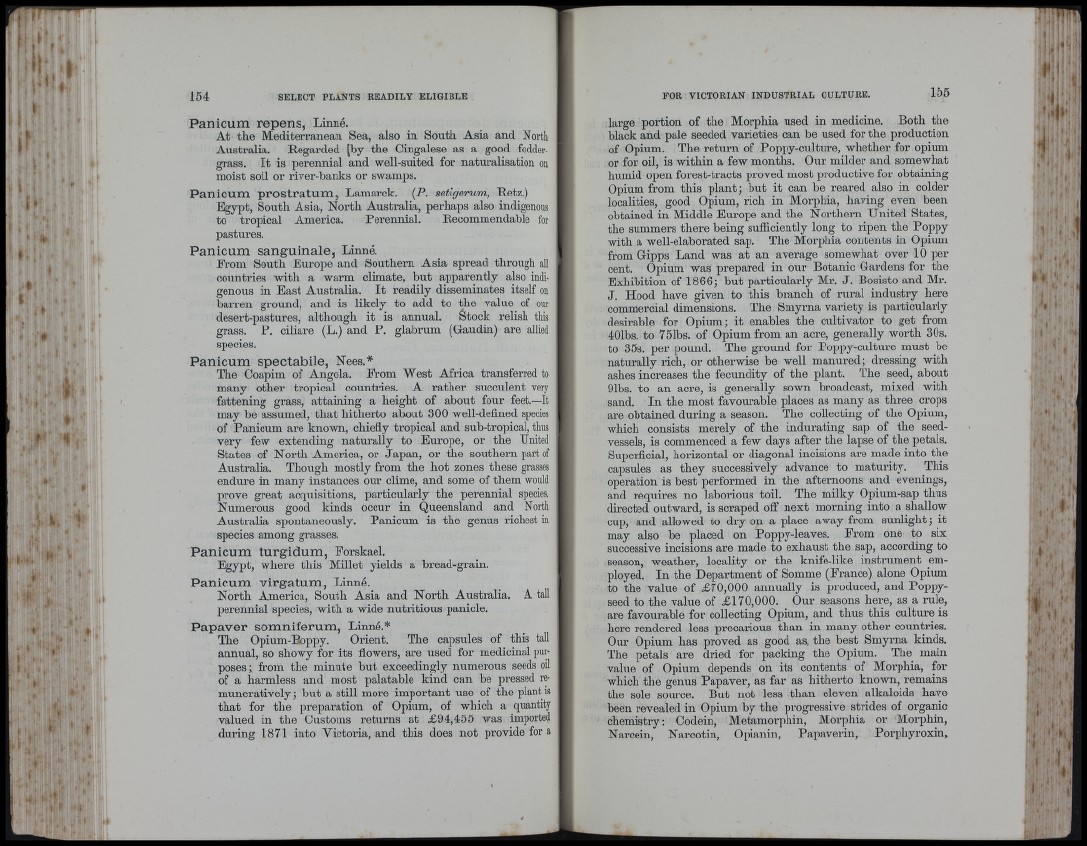
HIVI :
II ( ) 'i' '
1 ‘ ' 'U - '*! I
»■'1 • »
k “ «I
.*♦’ ’ ‘ ,1
‘ . I
‘ T I
i4 II, I
' ill I H .'H'. I
i. iIi i l l ll
1 ‘ ' f
i Ji,
' r
ll
ifli
É " : m i l
■ I' '"L
1 i'+ If!"
iU’ ß> ;
Jl
' *I |i»* ■ i Ull'”l
,« J
^ ' 'l''i"vIiiUii
’ : Ù/4 ■ .....
i ■!' fJ
' ■ 1 ! I ‘
:U „ " I ; 4
4. y •’
4 '’' - l ' U ' f
r 'fl ;.|i ,
154 SELECT PLANTS READILY ELIGIBLE
Panicum repens, Linné.
At the Mediterranean Sea, also in South Asia and North
Australia. Regarded [by the Cingalese as a good fodder-
grass. I t is perennial and well-suited for naturalisation on
moist soil or river-banks or swamps.
Panicum prostratum, Lamarck. (P. setigerum, Retz.)
Egypt, South Asia, North Australia, perhaps also indigenous
to tropical America. Perennial. Recommendable for
pastures.
Panicum sanguinale, Linné.
From South Europe and Southern Asia spread through all
countries with a warm climate, but apparently also indigenous
in East Australia. I t readily disseminates itself on
barren ground, and is likely to add to the value of our
desert-pastures, although it is annual. Stock relish this
grass. P. ciliare (L.) and P. glabrum (Gandin) are allied
species.
Panicum spectabile, Nees.*
The Coapim of Angola. Erom West Africa transferred to
many other tropical countries. A rather succulent very
fattening grass, attaining a height of about four feet.—It
may be assumed, th a t hitherto about 300 well-defined species
of Panicum are known, chiefly tropical and sub-tropical, thus
very few extending naturally to Europe, or the United
States of North America, or Japan, or the southern part of
Australia. Though mostly from the hot zones these grasses
endure in many instances our clime, and some of them would
prove great acquisitions, particularly the perennial species,
Numerous good kinds occur in Queensland and North
Australia spontaneously. Panicum is the genus richest in
species among grasses.
Panicum turgidum, Eorskael.
Egypt, where this Millet yields a bread-grain.
Panicum virgatum, Linné.
North America, South Asia and North Australia. A tall
perennial species, with a wide nutritious panicle.
Papaver somniferum, Linné.*
The Opium-Eoppy. Orient. The capsules of this tall
annual, so showy for its flowers, are used for medicinal purposes;
from the minute but exceedingly numerous seeds oil
of a harmless and most palatable kind can be pressed remuneratively
; but a still more important use of the plant is
th a t for the preparation of Opium, of which a quantity
valued in the Customs returns at £94,455 was imported
during 1871 into Yictoria, and this does not provide for a
f
FOR VICTORIAN INDUSTRIAL CULTURE. 155
large portion of the Morphia used in medicine. Both the
black and pale seeded varieties can be used for the production
of Opium. The return of Poppy-culture, whether for opium
or for oil, is within a few months. Our milder and somewhat
humid open forest-tracts proved most productive for obtaining
Opium from this plant; but it can be reared also in colder
localities, good Opium, rich in Morphia, having even been
obtained in Middle Europe and the Northern United States,
the summers there being sufficiently long to ripen tbe Poppy
with a well-elaborated sap. The Morphia contents in Opium
from Gipps Land was at an average somewhat over 10 per
cent. Opium was prepared in our Botanic Gardens for the
Exhibition of 1866; but particularly Mr. J . Bosisto and Mr.
J. Hood have given to this branch of rural industry here
commercial dimensions. The Smyrna variety is particularly
desirable for Opium; it enables the cultivator to get from
401bs. to 751bs. of Opium from an acre, generally worth 30s.
to 35s. per pound. The ground for Poppy-cultnre must be
naturally rich, or otherwise be well manured; dressing with
ashes increases the fecundity of the plant. The seed, about
Olbs. to an acre, is generally sown broadcast, mixed with
sand. In the most favourable places as many as three crops
are obtained during a season. The collecting of tbe Opium,
which consists merely of the indurating sap of the seed-
vessels, is commenced a few days after the lapse of the petals.
Superficial, horizontal or diagonal incisions are made into the
capsules as they successively advance to maturity. This
operation is best performed in the afternoons and evenings,
and requires no laborious toil. The milky Opium-sap thus
directed outward, is scraped off next morning into a shallow
cup, and allowed to dry on a place away from sunlight; it
may also be placed on Poppy-leaves. From one to six
successive incisions are made to exhaust the sap, according to
season, weather, locality or the knife-like instrument employed.
In the Department of Somme (France) alone Opium
to the value of £70,000 annually is produced, and Poppyseed
to the value of £170,000. Our seasons here, as a rule,
are favourable for collecting Opium, and thus this culture is
here rendered less precarious than in many other countries.
Our Opium has proved as good as, the best Smyrna kinds.
The petals are dried for packing the Opium. The main
value of Opium depends on its contents of Morphia, for
which the genus Papaver, as far as hitherto known, remains
the sole source. But not less than eleven alkaloids have
been revealed in Opium by the progressive strides of organic
chemistry: Codein, Metamorphin, Morphia or Morphin,
Narcein, Narcotin, Opianin, Papaverin, Porphyroxin,
l i
1'
141
I